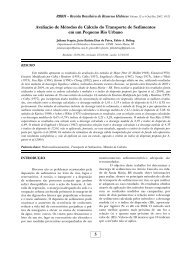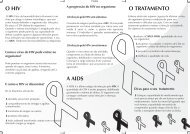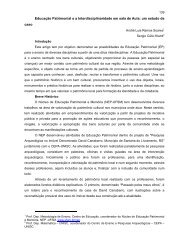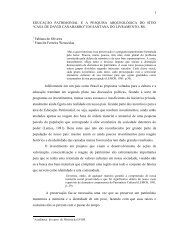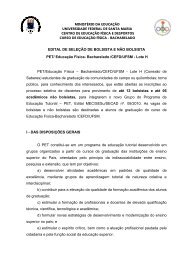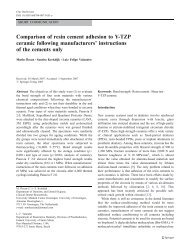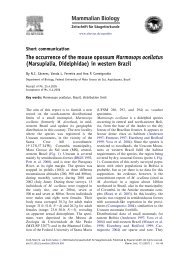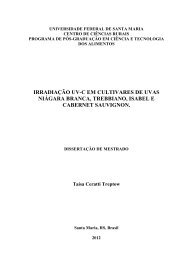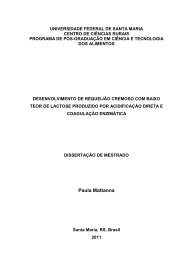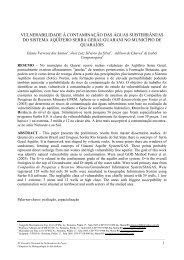DESENVOLVIMENTO E CARACTERIZAÇÃO FÃSICO ... - UFSM
DESENVOLVIMENTO E CARACTERIZAÇÃO FÃSICO ... - UFSM
DESENVOLVIMENTO E CARACTERIZAÇÃO FÃSICO ... - UFSM
Create successful ePaper yourself
Turn your PDF publications into a flip-book with our unique Google optimized e-Paper software.
60<br />
The first principal component (PC1) explains 69.0% of the variance in the initial data set<br />
and the second principal component (PC2) explain 6.9%. The projections of the samples along the<br />
directions identified by the first two PC’s, is reported in Fig. 1. First principal component (PC1)<br />
of wine treatments (scores) is plotted against the second principal component (PC2) in Fig.1.a. The<br />
separation of the different treatments applied to the wine is showed clearly through the scatter point<br />
plot. This figure shows that wines from the treatments fermented at 10 ºC were separeted by the<br />
first component analysis from those fermented at 20 ºC. Apparently treatments M7T10 and M2T20<br />
were not separated, however the completely separation were visualized with the aid of the third<br />
component (PC3) that explains 4.9% of the variance (data no showed). Fig. 1b shows the<br />
corresponding loadings plot that establishes the relative importance of each variable to discriminate<br />
the treatments. This figure shows that most of volatile compounds may be seen in the upper part of<br />
the plot, where PC1 and PC2 are positive and are strongly correlated to treatment (M7T20). The<br />
first component (PC1) was characterized by major concentration of the volatile compounds,<br />
including, ethyl hexanoate, methyl hexanoate, hexanoic acid and butyric acid. The esters and their<br />
corresponding acids, ethyl hexanoate and hexanoic acid and ethyl butyrate and butyric acid, are<br />
showing a positively correlation with the increases of temperature indicating a possible equilibrium<br />
hydrolyses reaction among these compounds (RAMEY & OUGH, 1980). The volatile compounds<br />
located in the negative PC2 are highly correlated to treatment (D2T10) that presented the lowers<br />
concentrations for the compounds. The upper part of the PC2 (positive) shows some volatile<br />
compounds that did not followed the same behavior of the most volatiles. 2-nonanol and methyl<br />
lavander ketone had its concentration not differing statistically to the treatments at 10 and 20 ºC,<br />
the same was observed for isoamyl acetate and 1-octanol. Therefore, it’s possible to conclude that,<br />
different temperatures had influenced the concentration of the volatile compounds in jelly palm<br />
wine and that a high fermentation temperature increases the volatile concentration. In general, the<br />
dilution of the must may be cause a dilution of the volatile compounds reducing its concentrations<br />
in the headspace of the wine. The influence of the treatments will be discussed for each chemical<br />
class of compounds in separate.<br />
3.3 Esters<br />
Most esters found in wine are produced by yeast, after cell division has essentially ceased.<br />
Straight-chain forms are synthetized from alcoholysis of the corresponding acids, which have been



